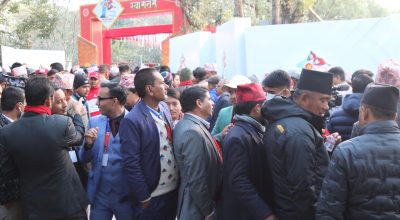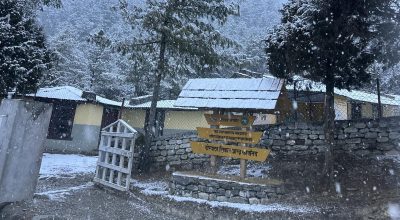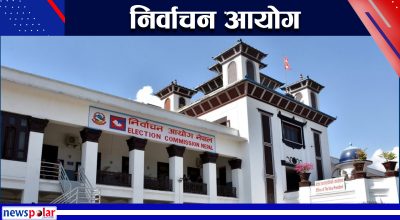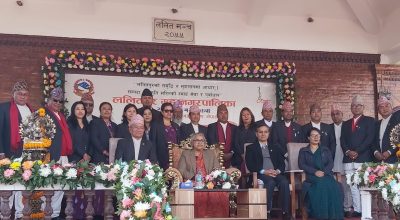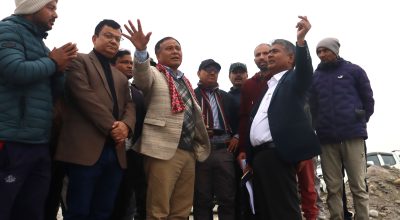
Pokhara, Sept 18: Constitution Day will be observed on Thursday to commemorate the day on Asoj 3, 2072 BS when the Constitution of Nepal was promulgated by the then Constituent Assembly. In this regard, Chief Minister Surendra Raj Pandey of Gandaki Province was interviewed by Rastriya Samachar Samiti (RSS) at the Gandaki Province Office of the Chief Minister and Council of Ministers. Excerpts from the interview:
What are the notable achievements in Gandaki Province since the promulgation of the Constitution of Nepal 2072 BS? How satisfied are you with its implementation progress?
Pandey: The Constitution of Nepal 2072 BS is a landmark document in the history of Nepal with significant public involvement. In the world, it is considered the latest Constitution. It has institutionalized a bicameral federal parliament, a federal structure of governance comprising seven provinces, and a three-tier government – federal, provincial, and local. However, despite these advancements, there have been challenges in implementing federalism effectively. All three-tier governments formed after the promulgation of the constitution have shown weaknesses in the implementation of federalism.
The federal governments also seem to struggle to enhance the capacities of local and provincial levels. There was a notable lack of human resources management in provincial and local governments at the outset of the implementation of federalism. While political federalism has been in place for seven years, administrative and financial federalism are still not fully operational at the provincial level.
The provincial governments face difficulties in meeting citizens’ expectations due to the absence of necessary federal laws and the lack of delegation of rights to the sub-national governments. Moreover, the Constitution’s provision that any provincial law inconsistent with federal laws is automatically repealed has further complicated the process of formulation and implementation of legislation at the provincial level. Despite these challenges, the provincial structures strive to remain accessible to the people, providing services and addressing grievances effectively. The provincial government is making efforts to meet public demands within the constraints of available resources, ensuring that those without access to the federal government find access and support from the provincial government.
Amid this, there has been a considerable improvement in cooperation and coordination with local governments, though the delivery of some public services has been hampered in the absence of legislation at the federal level. To address these issues and remove public frustration, it is crucial to delegate the rights to provincial and local governments as guaranteed by the constitution and fully implement the national charter. The federal government must focus on the implementation of administrative and financial federalism, as the province has the potential to achieve positive outcomes.
What are the existing structures/mechanisms and legal framework for the provincial government for implementing its policies and programs? What changes are needed in structures and legal framework to enhance effectiveness and credibility/reliability of the provincial government?
The provincial government faces challenges in executing policies, programs, and action plans due to the existing legal and structural framework. According to the Constitution, the provincial government serves primarily as a coordinating body, working alongside federal and local governments to implement its policies. However, federal laws often impede the implementation of these programs. For instance, while the Gandaki Province government has enacted the Province Police Act 2077 BS, its implementation is stalled because the federal government has not made the necessary adjustments among police forces.
Additionally, the provincial government is tasked with maintaining peace and security within the province, but it must seek federal approval to enhance security agencies, construct public buildings, and allocate resources. Such dependency often results in delays or impediment of programs due to the lack of federal government’s permission. To make provincial governments more powerful, effective, and reliable, the federal government needs to focus on implementing the principles of political, administrative, and fiscal federalism as outlined in the Constitution. Laws should be formulated and enforced promptly, and the provincial government should address public demands, manage resources efficiently, and work towards establishing credibility and public trust.
Conflicts among the federal, provincial, and local levels while implementing the Constitution of Nepal are reported, with claims that the federal government has restricted provincial authority and the provincial government has curtailed rights to the local level. How has the provincial government addressed these issues?
Conflicts often ensue due to ambiguities in laws and delays in implementing constitutional provisions. The constitution clearly delineates the jurisdictions of federal, provincial, and local governments, but delays in enforcing these provisions can give rise to conflicts. Coordination and cooperation among the three tiers of government would be more effective if we adhered strictly to constitutional guidelines and the envisioned state restructuring. Issues related to common problems and concurrent rights among the two-tier governments should be addressed in line with the federal act, with provincial acts devised accordingly. Some proactive provinces face challenges and are in a state of lawlessness due to the federal government’s indifference, despite demonstrating a willingness to deliver.
The persistence of a unitary mindset, despite the adoption of a federalism set-up, contributes to ongoing management problems regarding concurrent rights. As a Chief Minister, I have been actively advocating for provincial rights. I convened a summit of Chief Ministers from all provinces to address common concerns and presented these issues to the Prime Minister and the National Development Action Committee as well. Although we have repeatedly raised these issues with the federal government and highlighted the need for appropriate laws and authority for the provincial government, outcomes/results have been limited due to the federal government’s inaction towards the formulation and implementation of these laws.
There is increasing criticism that running provincial governments is too costly and provincial governments are suffering from a lack of financial independence and political freedom, leading to calls for the abolition of the federal system. At this backdrop, what steps can be taken to make provincial governments more stable, capable, functional, and responsive to the people?
First of all, let me clarify that running provincial government might seem a costly affair partly due to the transition from the previous system which included regional structures like District Administrative Offices and Village Development Committees. The new provincial and local government setup is actually more cost-effective in terms of human resource management and current expenditures. The provincial system is relatively new for us, and it’s understandable that there are reservations/grievances since the provincial government has not yet met all citizen expectations. However, before drawing conclusions about the provincial government’s effectiveness, it is crucial to provide a supportive environment for the provincial government to function properly.
The true measure of success should be assessed once the provincial government has had the opportunity to perform with the rights and resources granted by the federal government. To enhance the effectiveness and strength of provincial governments, it is essential to ensure that the rights delegated by the Constitution are fully delegated and implemented.
How have you implemented the law-making process in the province according to constitutional provisions for the orderly management of the provincial government?
Currently, the provincial government has implemented 47 regulations and another 25 regulations issued by the federal government. The creation of provincial laws has streamlined our work, though there have been challenges, particularly with federal laws that have not been enacted or fully implemented. For example, while we have put in place the Civil Service Act, its implementation has been hindered as the federal government has not issued the Act. Despite these issues, we have continued to advance the provincial government’s policies and programs by formulating legislation, regulations, and procedures specific to our jurisdiction.
We are committed to addressing any challenges relating to the implementation of our acts and regulations considering necessary amendments in them. However, questions are raised on how many adjustments can be considered in what issue in the absence of federal laws.
Some of the provincial pride projects are currently stalled. What policy and structural reforms are you considering to accelerate these developmental initiatives?
The provincial government has numerous pride projects that require substantial resources for successful implementation. We cannot achieve this solely with our capacity. Issues relating to economic rights have surfaced, particularly due to the federal government’s failure to transfer financial federalism and our inability to increase revenue due to the lack of enabling legislation. The limited resources available to meet the extensive needs of our citizens hinder our ability to carry out these projects independently. We understand collaboration with the federal government is essential. However, budget cuts from the federal government and lack of facilitation from the federal government for revenue-enhancing legislation coupled with our bleak financial condition impeded our progress. We need increased financial support and legislative facilitation from the federal government to advance these projects and strengthen our fiscal condition.
The second five-year periodic plan has been approved and is now being implemented under the federalism framework. What are the main goals of this plan, and what criteria will determine its success?
The provincial government has prioritized streamlining development projects with visible, tangible impacts on the public. Many objectives from the first five-year plan have been achieved, and those still pending have been incorporated into the second periodic plan. The second plan includes ambitious goals designed to advance the aspiration of the Gandaki Province government- “Prosperous Province with Happy Residents,” while considering the size of the available budget and availability of the resources. We have streamlined the development budget to avoid piecemeal and minor projects, focusing instead on more cohesive and impactful ones. I am confident that the plan will address both immediate needs and long-term aspirations of our citizens, leading to significant benefits for the province.
Finally, what message do you have for the people of Nepal, and specifically for the residents of Gandaki Province on the occasion of Constitution Day 2081 BS?
On the occasion of the Constitution Day, I extend my heartfelt wishes to all Nepalis, both at home and abroad. I honor the martyrs who sacrificed their lives for our nation. At this critical juncture, our focus must be on advancing economic development while upholding the constitution and reinforcing federal democratic governance. The provincial government is committed to implementing the Constitution in a way that uplifts the daily lives of our citizens. We are dedicated to collaborating with federal and local governments to drive economic prosperity and ensure social justice. I encourage all residents of Gandaki Province to lend a hand of support to these endeavors constructively. #constitution #nepal #RSS





